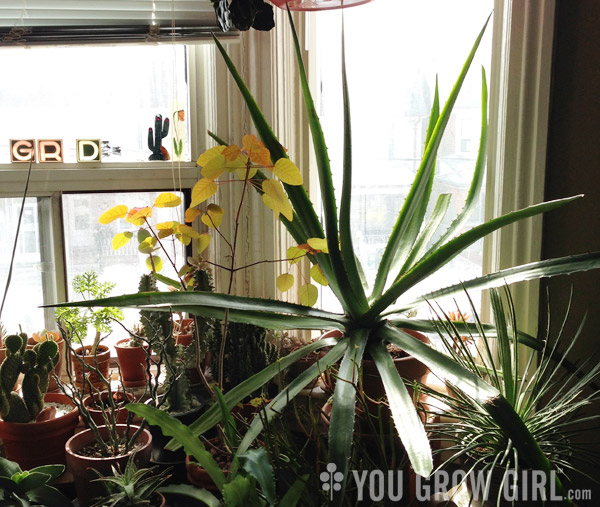
I kid. A little hyperbole on a Thursday afternoon. The leaves on this particular plant expand as much as 25″ across! Those of you living in warmer climates must wonder why in the heck I have such a large agave indoors! They’re big, heavy, and their spines are painful. At this size they are not exactly an appropriate house guest and I suspect that they break several principles of Feng Shui as it applies to the home or home office. Despite the negatives they are also some of my favourite plants. I have absolutely no resistance to their charms.
Back in the fall when my friend Uli came by with all of those pumpkins, she also brought along this agave. Here in Toronto, agaves don’t survive outdoors through the winter and must be brought inside. To be accurate, there are a few cold hardy species, but there are other factors that determine their hardiness and for the most part they really do need to come inside. Uli and her partner Paul collect agaves and so do I. They didn’t have space to overwinter this specimen so she offered it to me. Where there’s a will, there’s a way, and when it comes to a plant in need (especially an agave) I always seem to find it.
Later that day, I carefully pulled the leaves together, tied them loosely, and hauled that thing up a narrow stairway and into my office where there is a big(ish), south-facing window. I also snipped a few centimetres off of the long spines first as a precaution against the possibility of poking my eyes out. I was sure to situate it up high, away from my dog Molly’s reach. In late spring I will repeat the task in reverse so that the plant can enjoy the summer outdoors. I’m not yet sure how I’m going to work it into the design of my outdoor garden, but I look forward to the challenge!
Growing Agave in Pots
- Agaves are densely fibrous and heavy plants — they’re inordinately heavy for their size. Be aware that lifting a large plant can be backbreaking work.
- They have very deep root systems and require a much deeper pot than a typical succulent. I prefer rose pots (tall with sloping sides and a narrow bottom) because they are deep and drain exceptionally well.
- Be sure to use a pot with a good drainage hole. They do not like to sit in stagnant, wet soil.
- Potting Soil: Should be gritty and drain well. When in doubt, use a potting mix made for cacti and succulents.
- Mulch the soil surface with pea gravel and/or small rocks.
- Light: SUN and lots of it! In the winter months I crowd most of mine into a south-facing window and the rest go underneath lights in the basement. Then it is back outdoors for the summer. They really benefit from the time spent outdoors.
- When introducing outdoors: Be sure to place them in a shady spot and gradually transition to a sunny spot over the course of a few weeks.
- Moisture: I find that container-grown agaves require more water than most other succulent plants, even through the winter. Give them a good soak, but be sure to remove excess water from the drip tray within 30 minutes or so of watering. in the winter, allow the soil to dry within an inch of the top before watering again.
- Fertilize: In the spring and summer, only when the plant is actively growing. I use a little vermicompost scratched into the soil surface or water with a very diluted tea made with sea kelp and fish emulsion.
- Repot: Every few years or as soon as you see roots emerge through the drainage hole/s. I prefer to repot in the spring as soon as the plants begin active growth.
I used to keep a pineapple plant in my craftsroom during the short South Carolina winter. Before carrying it indoors, I would trim the bottom leaves. The pineapple leaves are as painfull as the agave leaves. I loved having my pineapple plant with me during the winter months. Now am living in the Caribbean, my pineplants are enjoying tropical weather 365 days per year.
Enjoy your agave.
What is that lovely yellow-leafed plant next to the agave?
It is Euphorbia cotinifolia. The leaves are actually burgundy, but at certain times of the day the sunlight illuminates them in such a way that they look yellow.
Your office window looks a lot like my dining room window. So many houseplants and so little winter sun. This year, however, the vast snow cover reflecting sunlight has been a big boost for houseplants here in PA.